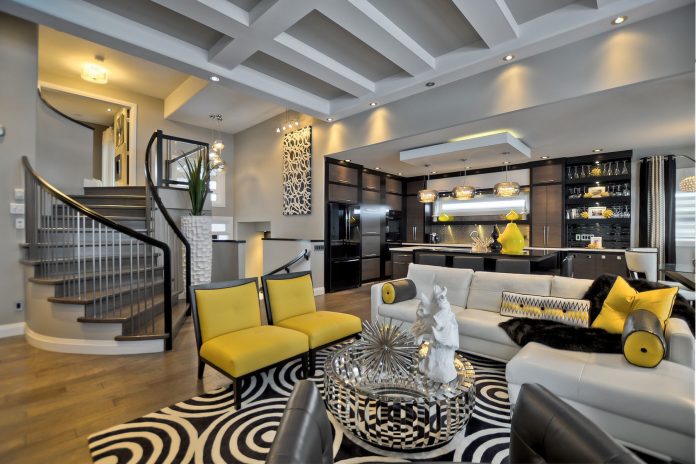A smart home is a place of living that makes use of internet-connected gadgets to allow for the remote control and monitoring of systems and appliances, like heating and lighting.
Smart home technology offers individuals security, comfort, convenience, and energy efficiency by enabling them to operate smart devices, typically through a smart home application on their mobile phone or another connected device. It is also known as home automation, or domotics, from the Latin word domus, meaning home.
Smart home systems and gadgets, which are a component of the internet of things (IoT), frequently work in tandem, exchanging usage data with one another and automating tasks according to the choices of the people who live there.
The Development of Smart Homes in History
In the past, houses were mainly static buildings—basic spaces where people lived. The introduction of smart home technology has allowed houses to become interactive environments that adjust to the requirements of the occupants. The main cause of this change is a collection of gadgets and technologies that go beyond conventional appliances and provide a degree of automation that was previously only found in science fiction.
A crucial example of this kind of technology is home automation. These systems connect multiple smart gadgets and provide homeowners with a single, centralized location to operate them, functioning as the hub of a smart home. It may be as easy as setting up a complex network of security cameras to deliver real-time footage to your smartphone, or it could be as complicated as programming your coffee machine to create your daily brew.
The use of IoT is another technical development that influences smart houses. With the use of this technology, devices can “talk” to one another over the internet, exchanging information and arranging actions without the need for human participation. For instance, over time, your smart thermostat can figure out what temperature you want and modify the heating or cooling system accordingly.
IoT has effectively taken on the role of the digital glue holding the smart home together by combining a variety of devices, such as security, entertainment, and lighting, to create a seamless, networked living environment.
Fundamentals of Smart Homes
Making the switch to a smart home is a slow but significant process. It’s not necessary to install a horde of futuristic devices overnight or to throw out all conventional appliances at once. Rather, the process usually begins with a single smart device, such as a smart lamp or speaker, and continues over time. An existing garage door opener can be upgraded into a smart one by adding a wall control panel to open or close the garage door. Then more gadgets can be gradually added as homeowners grow accustomed to the technology and its advantages, creating a complex network of interconnected systems that cooperate to make homes smarter.
A smart house requires a few basic components to be established. A reliable Internet connection is one of these. Having dependable and quick Internet is essential given the reliance on the Internet of Things, where gadgets talk and exchange data continuously via the network. It serves as the framework for your smart home, facilitating easy communication between all of your gadgets.
Naturally, the smart devices themselves are the other essential component in addition to the Internet. These could include sophisticated goods like washing machines or refrigerators, as well as security cameras, thermostats, and lighting controls. Your demands, tastes, and financial situation will all play a major role in the kind and quantity of devices you select.
A central hub or smart speaker, such as Google Home or Amazon Alexa, may also be necessary. These devices serve as conductors, coordinating the actions of all of your smart devices and enabling convenient control from one location.
Remember that patience is essential as you begin to see the potential of smart home technologies and take on this digital home transformation. It involves gradually creating a living area that complements your way of life, improving not just efficiency and convenience but also, in the end, your quality of life.
Parts of an Intelligent Home
A smart home’s design is complex and multifaceted, with multiple essential elements that work together to create a cohesive, networked living environment. Every part functions as a cohesive unit, like a well-oiled machine, to provide a smooth and effective living environment. The essential components consist of:
Smart appliances and gadgets
The obvious players are at the center of the smart home. These consist of smart refrigerators that can order goods when you’re running low, heating and cooling systems that adjust to your tastes and adaptive lighting systems. These gadgets are not only incredibly customizable and controllable, but they also use less energy overall.
Home automation systems
Taking on the role of the director, directing the players inside the system. With the help of this technology, homeowners may operate several smart devices from a single, centralized interface, and their interactions are made easier. This control can be anything from creating intricate security rules to establishing regular rituals like making coffee in the morning.
Sensors
A smart home’s sensory network is composed of a variety of sensors. These include sensors that monitor temperatures for smart thermostats, motion sensors for automated lighting, including smoke detectors for potential fire danger alerts.
Hubs and controllers for smart homes
These gadgets serve as the central nervous system. They make it possible to control every smart device from a single, central location. Your smart home hub is ready to receive your commands, whether they be to play your favorite music, turn up the heat, or dim the lights.
Smart home security systems
These systems act as a smart home’s watchful guardians. They protect the safety and security of your house with remote-controlled smart locks, security cameras that stream live footage to your smartphone, and alarm systems that notify you of suspicious behavior.
The true genius of the smart home is in how well these parts work together, each adding to an ecosystem that changes to suit you and makes your life easier, cozier, and safer.
It is crucial to always consider having a smart garage door as part of the ecosystem of a smart home. This is because it has various advantages. Having a smart garage door provides convenience, making opening and closing of the garage door practically effortless. This convenience also provides a homeowner ultimate control over the garage door through the use of an app. It also expected to improve security due to improved detection and sensors, making it perfect for families with small children and pets, lowering the possibilities of injuries and deaths caused by a heavy garage door.
What are the benefits of a smart home?
The following are some benefits that owning a smart house may provide:
You’ll get a more enjoyable and cozy home
It’s practical to have lights that turn on and off in response to a timetable or your presence. However, fun and comfort are also enhanced by smart LED illumination. LED lights that change color may make movie nights even more enjoyable and elevate dance celebrations to new heights. By automatically modifying the white light’s tone to stimulate you during the day and aid in your nighttime relaxation, tunable white LEDs can support the proper regulation of your circadian rhythm. You can now stream your favorite music in every room in your house at once by pairing a few sub-$50 smart speakers together. Smart speakers have made multiroom audio considerably easier and more affordable than it has ever been.
You’ll have a safer and more secure home
You can constantly monitor what’s happening in your house from anywhere with connected home alarm systems, cameras, locks, and lights that can all be controlled from afar and monitored from a smartphone or tablet. It is possible to program smart lighting to appear as though someone is home on a schedule. Giving someone access to your house without hiding a key under the flowerpot is possible with smart locks.
Your garage can also be your house’s greatest access point, so it is essential to maintain the highest level of safety. Modern technology is used by smart garage doors to safeguard your family and your house. If your kids are left alone at home, you can utilize the camera that comes with the gadgets to keep an eye on their whereabouts. In the event of an attempted break-in or unauthorized entry, your security system will instantly notify you and the security authorities of the incursion. You can use this function even if you are far from your home. To ensure that only authorized people can enter your garage, you can also incorporate facial recognition and fingerprint scanners into your garage door.
You can control your garage door even when you’re away
A smart home can also help you access and control your garage no matter where you go. and Conventional garage doors have a transmission that only works when the remote control is a few meters away; long distance remote controls are inoperable. With the help of smart garage door systems, you may operate your garage door from anywhere in the world.
Let’s say you are awaiting a shipment while on vacation. With the help of this clever device, you may let the delivery person into your house, let them safely set the gift inside, and then quickly shut the door once they’ve left. Considering that millions of parcels are lost or stolen every day in the US, this feature is quite essential.
Energy efficiency is more evident in your house
By reducing energy and water use, individual gadgets like smart sprinklers and thermostats can help save money and resources. Appliances with smart energy monitoring systems are able to recognize usage trends and make recommendations for energy-saving measures. Artificial intelligence is used by more modern systems, like Samsung’s SmartThings Energy service, to proactively modify energy use depending on data collection. For instance, it will raise the temperature by one degree overnight if it knows you never access your refrigerator between 11 PM and 5 AM.
A smarter home makes your living easier
Robotic vacuums, intelligent refrigerators, washing machines, and ovens can handle certain household tasks while assisting you with others. A smart oven can modify the cooking time so your turkey doesn’t overcook, a smart washer can inform its dryer equivalent which setting is appropriate for the load it just finished, and a smart fridge can monitor the food you have and alert you when you’re running low.
Your home will be even more accessible
While all of these features are beneficial, they can be life-changing for those who have restricted mobility. People with disabilities can have greater independence by using voice control or touchscreen devices like phones or tablets to operate locks, lights, shades, appliances, and other items. For kids or people with limited cognitive or physical abilities, smart buttons that initiate automation and routines provide an easy-to-use interface. Routines that are programmed to occur routinely in a person’s house can have a significant impact on their everyday life. For instance, an automation system can dim the lights at night while drawing the blinds, turn on smart lighting in the morning as you open the blinds and shades, and enhance the lights during the day for an elderly person who lives alone and has restricted mobility. This could be the difference between having to spend the entire day in the dark and feeling more a part of the outside world.
In a smart home, accessibility goes beyond simply providing assistance to those who face more obstacles than others. It’s also the long play of the smart home. When we get older, most of us prefer to spend as much time as possible in our own homes. If we equip our homes with linked gadgets today, they will be able to take care of us tomorrow, allowing us to “age in place.”
What are a smart home’s disadvantages?
If you’ve read this far, you might be thinking how fantastic this is because all of us do. However, the caution label now appears. The smart home has many problems, including compatibility, complexity, privacy, and security. One major drawback is that the smart house deteriorates immediately as you try to scale (unless you pay a lot further for a professional installation), even if those problems don’t bother you. Devices from the same manufacturer typically function well together, and individual devices perform admirably, but issues might occur when you attempt to integrate several devices into more intricate automation and routines, which are the ones that truly provide value.
These are the main disadvantages of the modern smart house.
Not everything is compatible with everything else
Your son’s Android phone won’t function with the smart bulb you purchased, but it might work with Apple Home and your iPhone. Even though your neighbor may own two Google Nest smart speakers, you won’t be able to enjoy multiroom music throughout your entire apartment because you own Amazon Echos. You will need to purchase a smart home hub in order to control your new Z-Wave smart lock.
These are only a few instances of the many reasons compatibility is problematic. It results in confusion, annoyance, and subsequent problems.
It becomes confusing sometimes
It can be challenging to decide which gadgets to get that will complement your current equipment. After selecting your new device, configuring it can be challenging. To set up the automation that gives a smart home its distinct smart feel, you’ll also need to invest some time learning how to connect it to your current gadgets and make the most of its features.
Matter was created in an attempt to address these two problems. Matter, a massive industry partnership involving Google, Samsung, Amazon, Apple, and many others, has the ability to resolve compatibility difficulties, which will significantly simplify the setup process for smart homes. However, Matter is still in its infancy and isn’t a practical solution for today unless it’s widely adopted by the industry.
It’s pricey
Adding smart technology raises the cost of a garage door opener, door lock, or lightbulb. In order to cover the continuous expenses of cloud servers and resources for offering feature and security upgrades to their goods, an increasing number of device manufacturers are also charging subscription fees for their products. Is it really worth spending extra money on a fresh opener for your garage or a retrofit smart controller since you are able to obtain extra for your money—a garage door you are able to close from the comfort of your office as opposed to one that stays open all day simply because you failed to close it?
It doesn’t always function
From excessive reliance on the internet (you won’t be happy if your Wi-Fi is down and you can’t control your lights) to weekends spent debugging the reason your smart speaker isn’t understanding a command it was working fine the previous week, the smart home is frequently not astute. Everything can be rather magical when it works, but it can also be incredibly annoying when it doesn’t.
It’s unsettling for some people
There are legitimate security and privacy issues with smart homes. In the end, a smart house needs to be trusted. Despite developments in edge machine learning, which eliminates the need for devices to process data on the cloud, you are still disclosing personal information about yourself to the corporations whose products you purchase for your house. That is, in my opinion, the main argument against implementing smart homes as they currently stand.


























